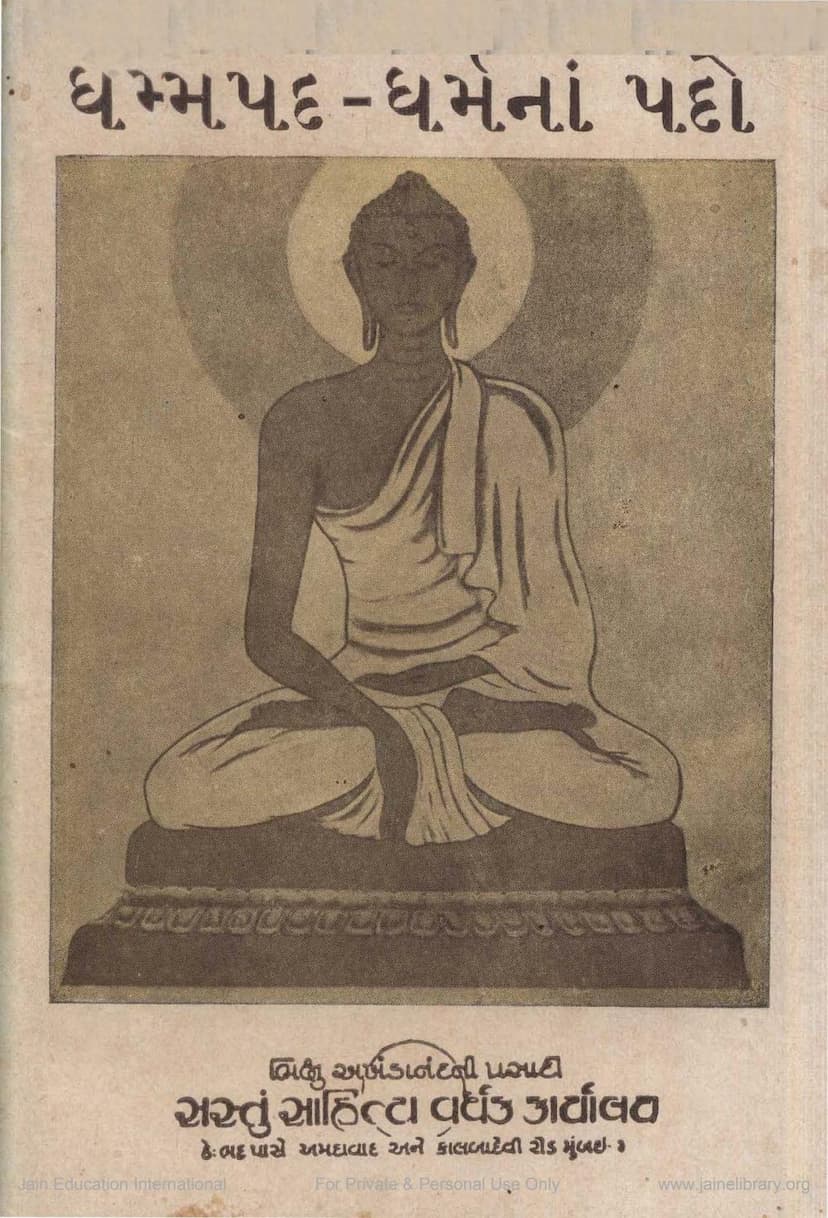Dharmna Pado Dhammapada
Added to library: September 1, 2025

Summary
Here's a comprehensive summary of the provided Jain text, focusing on the essence of the "Dhammapada" as presented in this Gujarati translation and commentary:
Title: Dharmna Pado Dhammapada (The Verses of Dharma - Dhammapada) Author: Pandit Becherdas Doshi Publisher: Sastu Sahityavardhak Karyalay, Mumbai Catalog Link: https://jainqq.org/explore/004695/1
This book, "Dharmna Pado Dhammapada," is a Gujarati translation and commentary of the Buddhist scripture Dhammapada, edited by Pandit Becherdas Doshi and published by Sastu Sahityavardhak Karyalay. The preface highlights the universal appeal of Lord Buddha's teachings, emphasizing truth and non-violence as essential for human connection and spiritual progress. The publisher expresses joy in presenting this significant work to Gujarati readers, considering it comparable to the Bhagavad Gita within Indian traditions.
Key Themes and Commentary:
- The Nature of Mind and Thought: The commentary strongly emphasizes that the mind is the precursor to all phenomena. "Mind leads all phenomena, mind is supreme, and all phenomena are mind-made." This core principle, central to the Dhammapada, is elaborated upon, stating that impure thoughts lead to suffering, while pure thoughts lead to happiness. The importance of cultivating a pure and controlled mind is paramount.
- The Role of Conduct and Self-Discipline: The text repeatedly stresses the necessity of self-control, restraint, and disciplined behavior. This is illustrated through various metaphors, such as the charioteer controlling his horses or the craftsman shaping wood. The verses advocate for mindful action, speech, and thought, emphasizing that true spiritual progress comes from internal discipline, not external rituals or appearances.
- The Transience of Life and the Pursuit of Liberation: The Dhammapada, as presented here, underscores the impermanence of the physical body and worldly attachments. It describes the body as fragile like a water bubble or a mirage, destined for decay and death. This understanding motivates the pursuit of liberation (Nirvana) from the cycle of birth and death.
- The Importance of Non-Violence and Compassion: While the Dhammapada is a Buddhist text, the commentary, through its comparative approach with Vedic and Jain traditions, implicitly promotes universal virtues. The emphasis on "Ahimsa" (non-violence) as a fundamental principle is woven throughout the discussion of various virtues.
- The True Meaning of a Brahmin and a Monk: The text redefines the concepts of "Brahmin" and "Bhikkhu" (monk) not by birth, caste, or external markers like matted hair or robes, but by their inner qualities. A true Brahmin or monk is characterized by the absence of anger, greed, delusion, attachment, and the practice of truth, compassion, restraint, and self-discipline.
- The Danger of Attachment and Desire: The commentary highlights desire (Trishna) as the root cause of suffering. It uses powerful metaphors like a vine that, if not uprooted, continues to cause rebirth and pain. The pursuit of worldly pleasures and attachments is depicted as a snare that leads to suffering and prevents spiritual progress.
- The Path to Happiness and Liberation: The book guides readers towards happiness and liberation through the cultivation of virtues such as non-violence, truthfulness, self-control, detachment, equanimity, and the practice of mindfulness and meditation. It emphasizes that true happiness is found not in external pleasures but in inner peace and the eradication of desires.
- Interfaith Harmony and Shared Principles: The editor, Pandit Becherdas Doshi, draws parallels between the teachings of the Dhammapada and the core tenets of Vedic (Hinduism) and Jain traditions. He argues that despite surface differences, the underlying spiritual principles of love, compassion, truth, and self-realization are common to all major Indian religions. The book advocates for interfaith understanding and respect to overcome societal divisions and foster harmony.
- The Significance of the Dhammapada: The text positions the Dhammapada as a foundational scripture in Buddhist tradition, akin to the Bhagavad Gita in the Vedic tradition. It presents the verses as concise and profound teachings on ethical conduct and spiritual wisdom, aimed at leading individuals to a life of peace and liberation.
- Commentary Style: Pandit Becherdas Doshi's commentary is noted for its clarity and its effort to make the profound philosophical concepts accessible to the common reader. He also engages in etymological discussions of key terms and provides comparative insights with other Indian religious traditions, highlighting the shared humanistic and spiritual aspirations.
In essence, "Dharmna Pado Dhammapada" serves as an accessible gateway to the timeless wisdom of the Dhammapada, contextualized within the broader Indian spiritual landscape. It advocates for a life of virtue, mental discipline, and detached living as the path to enduring happiness and freedom from suffering.